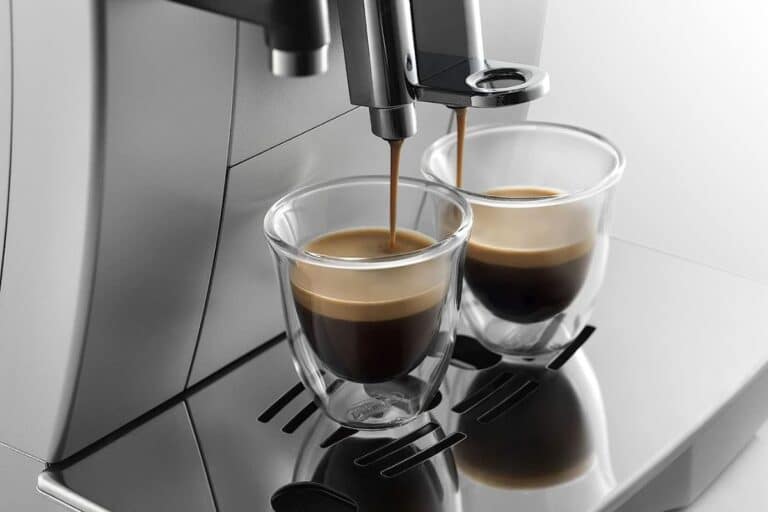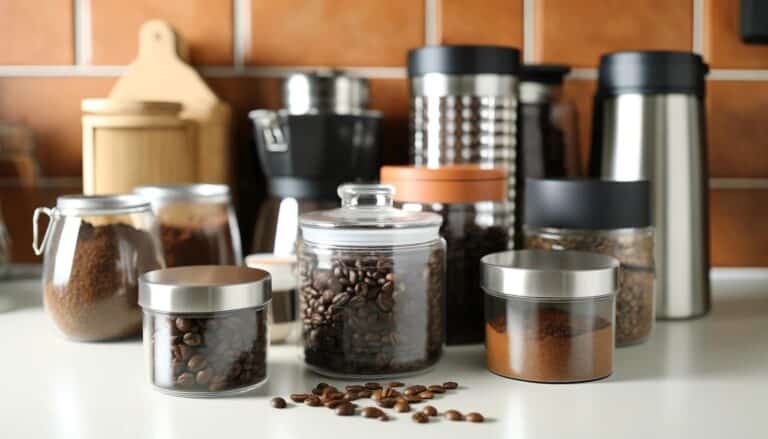Choosing the right coffee grinder is key to making the perfect cup of coffee. With so many types of grinders available, it can be overwhelming to decide which one is best for your needs. Understanding the differences between them will help you choose the right tool to make your morning coffee experience even better. Let’s explore the various types of coffee grinders, their features, and how they affect the flavor of your brew.
Blade Coffee Grinders
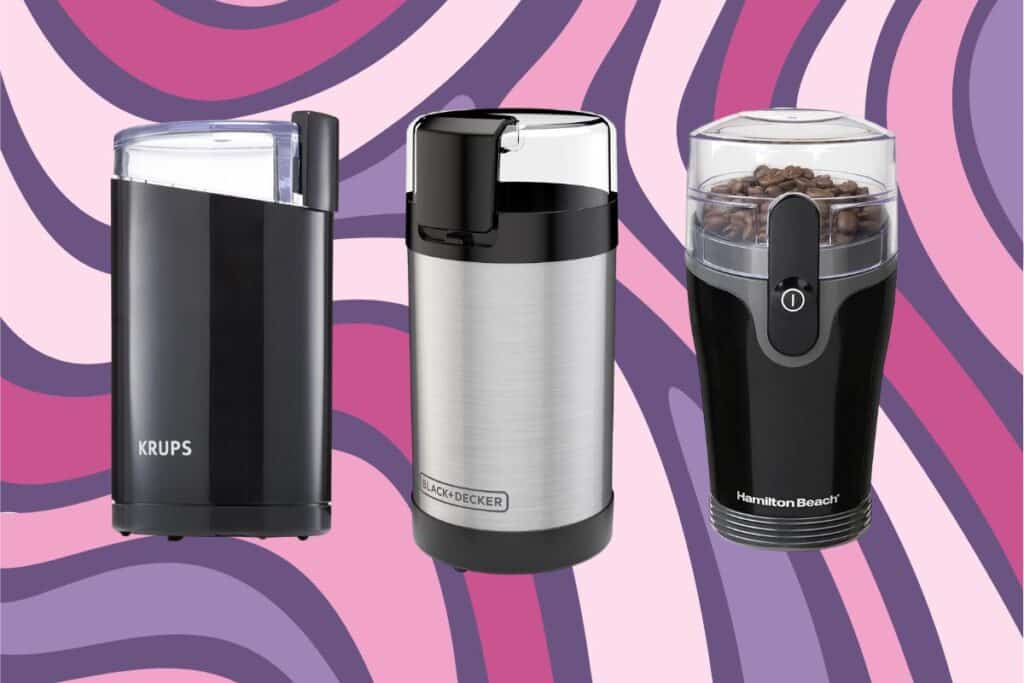
Blade grinders are one of the most accessible options for coffee lovers, especially for those just beginning their journey into brewing at home. These grinders are often found in kitchen appliance stores and are usually the go-to option for those looking for a simple, budget-friendly solution. However, despite their popularity, blade grinders come with certain drawbacks that should be considered before purchasing.
How Blade Grinders Work
A blade grinder operates similarly to a blender, using a rapidly spinning blade to chop the coffee beans. The blades rotate at high speeds, cutting the beans into smaller pieces. Most blade grinders have a simple on/off switch or button, making them straightforward to use. To adjust the grind size, you typically need to control how long you run the grinder—short bursts for a coarse grind and longer grinding times for finer grounds.
However, the reliance on timing rather than specific settings makes achieving a consistent grind more difficult. The blades cut beans unevenly, which can lead to a mix of fine powder and larger chunks of coffee, commonly referred to as “boulders and fines.” This inconsistency can affect the flavor and balance of your coffee, especially with brewing methods like espresso or pour-over that require a uniform grind for optimal extraction.
Pros of Blade Grinders
- Affordability: One of the biggest advantages of blade grinders is their low cost. Many models are available for under $20, making them an attractive choice for beginners or those on a tight budget. If you’re just getting into coffee brewing and aren’t ready to invest in a high-end burr grinder, a blade grinder can be a good starting point.
- Ease of Use: Blade grinders are incredibly simple to operate. Most feature a single button or switch, which controls both the power and the duration of the grind. You don’t have to deal with complex settings or dials, making them convenient for casual coffee drinkers who want a quick and easy solution.
- Compact Size: Blade grinders are generally smaller and more compact than burr grinders, which makes them ideal for those with limited kitchen space. They’re easy to store and can be pulled out quickly when needed without taking up much counter space.
- Multi-Purpose Use: Some people use blade grinders for more than just coffee beans. They can also grind spices, nuts, and seeds, making them a versatile tool in the kitchen. However, it’s important to clean the grinder thoroughly between uses to avoid flavor contamination.
Cons of Blade Grinders
- Inconsistent Grind: The primary disadvantage of blade grinders is the lack of control over the grind size. Since the blades chop the beans randomly, you often end up with a mixture of fine particles and larger chunks. This inconsistency can result in uneven extraction during brewing, leading to coffee that may taste over-extracted (bitter) or under-extracted (sour).
- How It Affects Brewing: In brewing methods like French press or cold brew, a coarse and uniform grind is essential to avoid over-extraction. With blade grinders, the uneven grind can leave fine particles in your coffee, which may result in a muddy texture or bitter flavor. For pour-over or espresso, which require a finer and more precise grind, the inconsistency from a blade grinder can be even more problematic, leading to poor flavor extraction.
- Heat Generation: Blade grinders spin at high speeds, and this rapid motion generates heat. Coffee beans are sensitive to heat, and excessive warmth during grinding can cause the beans to lose some of their essential oils. These oils are critical to the flavor and aroma of the coffee. Even a slight rise in temperature can affect the overall taste, leading to a flatter or burnt flavor in your final cup.
- Lack of Grind Settings: Unlike burr grinders, which allow you to select specific grind settings for different brewing methods, blade grinders offer no such control. The only way to adjust the grind size is to manually control how long you run the grinder. This can make it difficult to achieve the perfect grind for different brewing styles, particularly when trying to make espresso, which requires a fine, consistent grind.
- Noise: Blade grinders are often noisy due to the high-speed spinning blades. If you’re grinding coffee early in the morning or in a household with others, the loud operation can be disruptive. Burr grinders, by comparison, tend to operate more quietly.
Tips for Getting the Most Out of a Blade Grinder
If you already own a blade grinder or are set on purchasing one, here are a few tips to help improve its performance:
- Pulse the Grinder: Rather than holding the power button down continuously, use short bursts or pulses to avoid overheating the coffee beans. This also helps create a somewhat more even grind by redistributing the beans between pulses.
- Shake the Grinder: During grinding, gently shake the grinder between pulses to help redistribute the beans. This may improve the evenness of the grind, though it won’t completely eliminate the issue of inconsistency.
- Grind in Small Batches: If you overload the grinder, it can struggle to chop the beans evenly. For better results, grind in smaller batches and avoid overfilling the chamber.
- Clean Regularly: Since blade grinders can also be used for grinding spices or other dry goods, it’s important to clean the grinder thoroughly after each use. Residual oils and particles can alter the flavor of your coffee if they’re left behind from previous grinds.
Best Use Cases for Blade Grinders
While blade grinders may not be the best choice for coffee connoisseurs or those who need precision in their brewing, they can still be a useful tool for casual coffee drinkers. Here are some scenarios where a blade grinder might be appropriate:
- For Drip Coffee or French Press: If you’re using a drip coffee maker or a French press and don’t mind a little variation in your grind size, a blade grinder can suffice. These brewing methods are generally more forgiving than pour-over or espresso when it comes to grind consistency.
- For Beginners: If you’re just starting out and aren’t yet ready to invest in a high-quality burr grinder, a blade grinder can give you an introduction to home grinding without the upfront cost of more advanced equipment.
- For Multi-Purpose Grinding: If you plan to use your grinder for more than just coffee beans, such as grinding spices or seeds, a blade grinder can serve multiple purposes in the kitchen. Just be sure to clean it thoroughly between uses.
Is a Blade Grinder Right for You?
Ultimately, the choice of whether to go with a blade grinder depends on your coffee needs and how much you value grind consistency. If you’re just getting started with coffee brewing and need a budget-friendly option, a blade grinder can be a practical entry point. However, if you’re serious about the quality and flavor of your coffee, it might be worth investing in a burr grinder, which offers superior consistency and control.
Blade grinders are ideal for those who prioritize convenience and affordability, but if you want to step up your coffee game, consider upgrading to a burr grinder in the future.
Burr Coffee Grinders
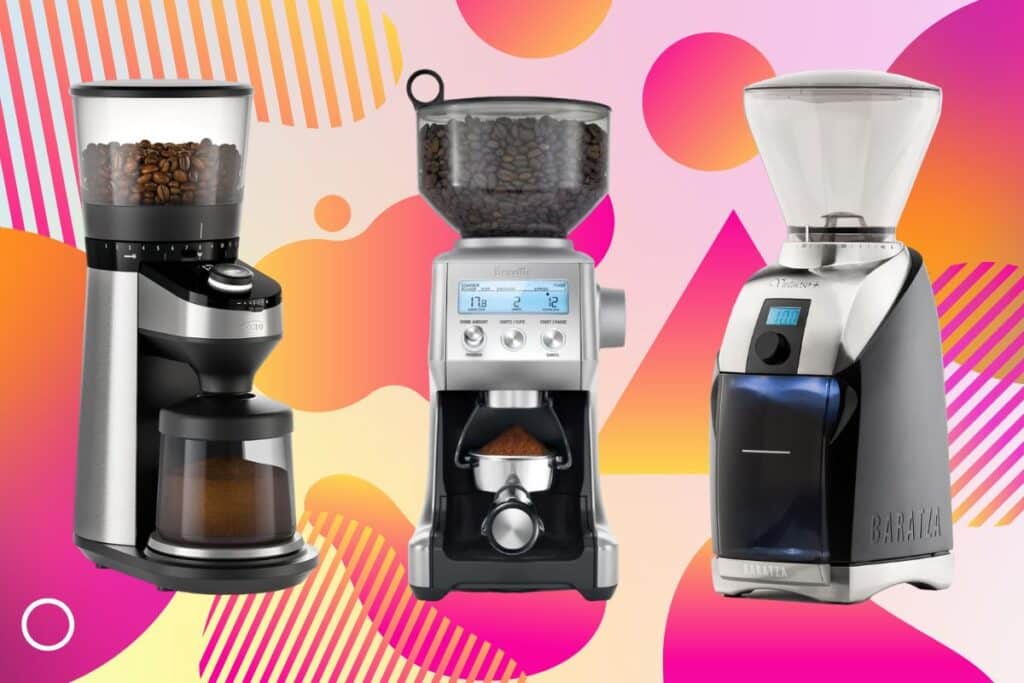
Burr grinders are widely regarded as the best option for achieving a consistent, high-quality grind. Unlike blade grinders, which rely on cutting beans with rotating blades, burr grinders crush coffee beans between two abrasive surfaces—known as burrs—to create a uniform grind. This precise control over the grind size is crucial for extracting the best flavors from your coffee beans, making burr grinders a popular choice among coffee enthusiasts and professionals alike.
How Burr Grinders Work
At the heart of a burr grinder are two burrs—one stationary and one that rotates. The beans are fed into the space between these burrs, and as they pass through, they are ground to a consistent size. The distance between the burrs can be adjusted to produce different grind sizes, ranging from fine for espresso to coarse for French press.
This adjustable feature makes burr grinders highly versatile, as they can be fine-tuned for a wide variety of brewing methods. Additionally, because burr grinders crush rather than chop the beans, they create a more consistent grind. This consistency ensures that all the coffee particles are the same size, leading to an even extraction and, ultimately, a better-tasting cup of coffee.
Types of Burr Grinders
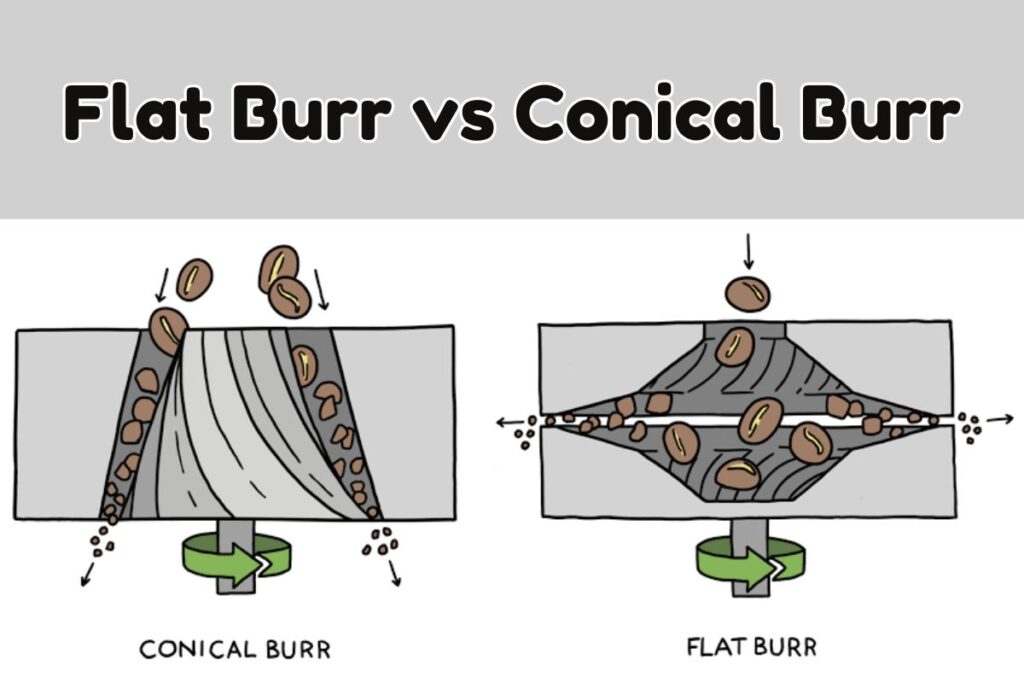
There are two main types of burr grinders: flat burr grinders and conical burr grinders. Each type has its own unique design and advantages, and the choice between them often comes down to personal preference and specific brewing needs.
Flat Burr Grinders
Flat burr grinders use two flat, parallel discs (burrs) to grind coffee beans. These discs have sharp ridges that grind the beans as they fall between them. The grind size is determined by the distance between the discs, which can be adjusted to achieve the desired coarseness.
Pros of Flat Burr Grinders:
- Consistent Grind: Flat burr grinders are known for producing an exceptionally consistent grind, which is particularly important for espresso and other brewing methods that require precision.
- Ideal for Espresso: Many professional espresso machines are paired with flat burr grinders because they deliver the fine, uniform grind needed for making high-quality espresso shots.
- Minimizes Clumping: Flat burr grinders often result in less clumping of coffee grounds compared to conical burr grinders, which can help ensure an even extraction.
Cons of Flat Burr Grinders:
- Higher Heat Generation: One downside to flat burr grinders is that they tend to generate more heat during the grinding process. This heat can affect the oils in the coffee beans, slightly altering the flavor if not managed properly. However, high-end models often incorporate cooling mechanisms to counteract this issue.
- Noisier: Flat burr grinders are often louder than conical burr grinders due to their design and the speed at which they operate.
- Cost: Flat burr grinders are typically more expensive than conical burr grinders, especially those designed for commercial use. While there are affordable models available for home use, the highest quality flat burr grinders are often priced in the premium range.
Conical Burr Grinders
Conical burr grinders, as the name suggests, use burrs shaped like cones to grind coffee beans. One burr remains stationary while the other rotates, and the beans are crushed between the conical surfaces. This design allows for slower grinding, which reduces heat buildup and helps preserve the natural oils and flavors of the coffee.
Pros of Conical Burr Grinders:
- Lower Heat Generation: Conical burr grinders tend to operate at a slower speed than flat burr grinders, which minimizes heat buildup. This helps preserve the flavor and aroma of the beans, making them a great option for brewing methods that emphasize delicate flavors, such as pour-over or cold brew.
- Quieter: Conical burr grinders are often quieter than their flat burr counterparts, thanks to their slower speed and design. If noise is a concern, a conical burr grinder might be a better option.
- Energy-Efficient: The slower operation of conical burr grinders makes them more energy-efficient, which can be a benefit in both home and commercial settings.
Cons of Conical Burr Grinders:
- Less Consistent at Finer Grinds: While conical burr grinders excel at producing consistent coarse and medium grinds, they may not be as precise as flat burr grinders when it comes to fine grinds for espresso. However, many high-quality conical burr grinders still offer excellent performance across the grind size spectrum.
- Clumping: Conical burr grinders can sometimes cause grounds to clump, especially at finer settings. This can impact even extraction during brewing, although this issue is often minimized in higher-end models.
Manual vs. Electric Burr Grinders
In addition to choosing between flat and conical burrs, you’ll also need to decide whether to go with a manual or electric burr grinder. Each option has its own set of advantages and disadvantages, depending on your personal needs and preferences.
Manual Burr Grinders
Manual burr grinders use hand power to rotate the burrs and grind the coffee beans. They often feature a hand crank and are usually designed with conical burrs. These grinders are portable and ideal for coffee lovers who want to grind their beans on the go, such as while traveling or camping.
Pros of Manual Burr Grinders:
- Portability: Manual grinders are small, lightweight, and don’t require electricity, making them perfect for travel or outdoor use.
- Affordability: Manual burr grinders are often more affordable than electric burr grinders. While high-end manual models exist, most manual grinders are priced lower than electric versions.
- Quiet Operation: Since they don’t use a motor, manual burr grinders are much quieter than electric ones, which is great for early-morning coffee grinding without disturbing others.
Cons of Manual Burr Grinders:
- Effort Required: Grinding by hand can be time-consuming and labor-intensive, especially if you’re grinding a large quantity of beans.
- Limited Capacity: Most manual grinders have a smaller capacity than electric grinders, so they’re better suited for grinding just a few cups of coffee at a time.
Electric Burr Grinders
Electric burr grinders use a motor to rotate the burrs and grind the coffee beans. They offer a more convenient and efficient way to grind coffee, making them a popular choice for home and commercial use.
Pros of Electric Burr Grinders:
- Convenience: Electric burr grinders are fast and easy to use, allowing you to grind a large quantity of coffee beans in a short amount of time with minimal effort.
- Grind Consistency: High-quality electric burr grinders provide highly consistent grinds, ensuring uniform extraction and better flavor for any brewing method.
- Adjustability: Many electric burr grinders come with a wide range of grind settings, making them versatile for different brewing methods, from espresso to French press.
Cons of Electric Burr Grinders:
- Noise: Electric burr grinders can be noisy, especially at higher speeds. However, some models are designed with noise reduction features to mitigate this issue.
- Cost: Electric burr grinders tend to be more expensive than manual grinders. The price can range from affordable models for home use to high-end, professional-grade grinders that cost several hundred dollars.
- Size: Electric burr grinders are generally larger and bulkier than manual grinders, which may be a consideration if you have limited kitchen space.
Key Features to Consider When Choosing a Burr Grinder
When shopping for a burr grinder, there are several important factors to consider to ensure you choose the right model for your needs:
- Grind Settings: Look for a grinder that offers a wide range of grind settings. This will give you more flexibility to experiment with different brewing methods and grind sizes.
- Grind Consistency: Consistency is one of the main reasons people choose burr grinders. Make sure the grinder you choose produces an even grind, especially if you’re brewing espresso or pour-over.
- Speed: While faster grinders may seem like a good idea, slower grinders often produce better results because they generate less heat. Low-speed grinders, also known as “direct drive” grinders, are generally preferred for preserving the flavor and aroma of the coffee beans.
- Capacity: Consider how much coffee you typically brew and choose a grinder with a hopper size that matches your needs. Larger grinders are ideal for brewing large quantities of coffee, while smaller grinders are better for single servings.
- Build Quality: Look for a grinder made from durable materials, such as stainless steel or high-quality plastic. A sturdy build ensures the grinder will last longer and perform better over time.
Which Burr Grinder is Right for You?
The best burr grinder for you will depend on your specific brewing preferences, budget, and how much control you want over the grind size. Here are a few key considerations:
- For Espresso Lovers: If you primarily brew espresso, a flat burr grinder might be the best choice due to its ability to produce a highly consistent, fine grind.
- For Versatile Brewing: If you like to experiment with different brewing methods—such as French press, drip coffee, and espresso—a conical burr grinder offers the flexibility to adjust grind sizes while preserving the coffee’s flavor.
- For Beginners: If you’re new to coffee grinding, an affordable manual or entry-level electric burr grinder can be a great way to start improving your coffee without breaking the bank.
Burr grinders are the preferred choice for serious coffee drinkers due to their superior grind consistency and control over grind size. Whether you choose a flat or conical burr grinder, manual or electric, investing in a quality burr grinder will enhance the flavor and enjoyment of your coffee. Taking the time to choose the right grinder for your brewing needs will help you achieve better results and elevate your coffee experience.
Manual Coffee Grinders
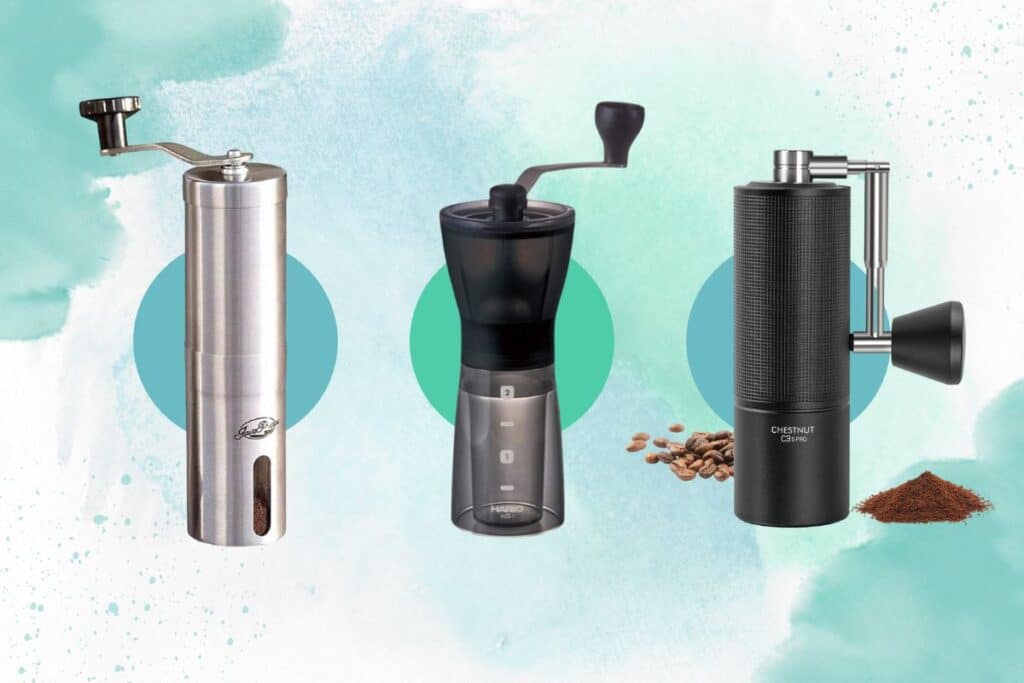
Manual coffee grinders have been around for centuries and remain a popular choice among coffee enthusiasts who prefer a more hands-on approach. These grinders offer a level of control and portability that electric grinders often can’t match. Despite their slower, more labor-intensive process, many coffee lovers appreciate the precision, consistency, and quiet operation of manual grinders. In this section, we’ll dive deeper into what makes manual coffee grinders a unique and valuable tool for brewing great coffee.
How Manual Coffee Grinders Work
Manual coffee grinders, also known as hand grinders, operate through a simple mechanical process. They consist of a crank handle connected to a grinding mechanism—typically burrs—that crush the coffee beans. As you turn the handle, the beans are ground between the burrs, falling into a lower chamber or drawer where the ground coffee is collected.
The grind size is adjustable by tightening or loosening a screw or dial that alters the distance between the burrs, allowing for a range of grind sizes from coarse to fine. Since manual grinders generally use burrs instead of blades, they produce a more consistent grind than many electric blade grinders, making them ideal for brewing methods that require precision, such as espresso or pour-over.
Pros of Manual Coffee Grinders
- Portability: One of the biggest advantages of manual grinders is their portability. Without the need for electricity, they can be used virtually anywhere, whether you’re at home, camping, traveling, or in the office. Their compact size makes them easy to pack in a bag or suitcase, making them a favorite among coffee lovers who like to enjoy freshly ground coffee on the go.
- Affordability: Manual grinders are generally more affordable than electric burr grinders, with prices ranging from budget-friendly to high-end models that rival the quality of electric grinders. This makes them an excellent entry point for those who want to improve their coffee without investing heavily in an electric grinder.
- Quiet Operation: Unlike electric grinders, which can be noisy, manual grinders operate quietly. This is especially convenient if you’re making coffee early in the morning or in a shared space where noise might be disruptive. You won’t have to worry about waking others or disturbing the peace while preparing your coffee.
- Precision and Consistency: Despite their simplicity, many manual grinders offer impressive grind consistency, particularly those with high-quality burr mechanisms. You can adjust the grind size to suit different brewing methods, from coarse grinds for French press to fine grinds for espresso. Some high-end manual grinders even outperform electric models in terms of grind quality.
- Durability: Manual grinders tend to have fewer moving parts and no electronic components, which makes them highly durable and less prone to mechanical failure. A well-made manual grinder can last for many years with minimal maintenance.
Cons of Manual Coffee Grinders
- Effort Required: The most obvious downside to manual grinders is the physical effort required to grind the beans. While some enjoy the tactile nature of hand grinding, it can become tiring, especially if you’re grinding a large quantity of coffee or if you need a fine grind for espresso. Grinding for multiple cups of coffee or for use in a French press can take several minutes, which may be inconvenient for those who are short on time.
- Limited Capacity: Most manual grinders have a relatively small capacity compared to electric grinders. This means you may need to refill and grind multiple batches if you’re making coffee for several people. For single-cup brewing methods like pour-over or AeroPress, a manual grinder’s capacity is usually sufficient, but for larger brew sizes, it can be limiting.
- Time-Consuming: Grinding beans by hand is naturally slower than using an electric grinder. If you’re in a rush or need to make multiple cups of coffee, a manual grinder may not be the most efficient option. The time it takes to grind will vary depending on the coarseness of the grind and the amount of coffee you’re preparing, but it generally requires more patience than electric options.
Types of Manual Coffee Grinders
There are various types of manual coffee grinders available on the market, ranging in design, size, and quality. Here are the most common styles:
1. Traditional Wooden Manual Grinders
These grinders have a nostalgic design, reminiscent of vintage coffee grinders. They usually feature a wooden base with a small drawer where the ground coffee collects. The crank is typically positioned on top, with a decorative knob. Traditional wooden grinders often use burr mechanisms and are a favorite for those who enjoy a classic aesthetic in their kitchen.
- Pros: Charming design and sturdy construction.
- Cons: Can be bulkier than more modern portable models and may not offer as much precision in grind size adjustments.
2. Stainless Steel Manual Grinders
These are modern, sleek grinders made from stainless steel, designed for portability and durability. They’re compact, often cylindrical in shape, and can easily fit in a bag or backpack. Stainless steel grinders are typically equipped with conical burrs, which provide a consistent grind, and their minimalistic design makes them ideal for travel or small kitchens.
- Pros: Lightweight, durable, and portable.
- Cons: Smaller capacity, and the design may lack the charm of traditional grinders.
3. Ceramic Burr Manual Grinders
Some manual grinders use ceramic burrs instead of steel burrs. Ceramic burrs are highly durable and resistant to heat, which makes them a popular choice for those looking to preserve the flavor of their coffee beans. They are also less likely to wear down over time compared to metal burrs, ensuring long-lasting performance.
- Pros: Heat-resistant, durable, and provide a consistent grind.
- Cons: Ceramic burrs can be more brittle than metal, so they need to be handled carefully to avoid chipping.
4. Travel-Friendly Manual Grinders
These grinders are designed specifically with portability in mind. They are compact, lightweight, and often feature ergonomic designs that make them easy to pack and use on the go. Travel grinders are usually made from lightweight materials like plastic or stainless steel and are perfect for those who want freshly ground coffee while camping, hiking, or on vacation.
- Pros: Lightweight, compact, and easy to carry.
- Cons: Smaller capacity and may not have as many grind settings as larger models.
Features to Look for in a Manual Coffee Grinder
When choosing a manual grinder, there are a few key features to consider to ensure you get the best performance and value for your needs:
- Burr Quality: The quality of the burrs is one of the most important factors in determining grind consistency. Look for grinders with high-quality steel or ceramic burrs, as these will produce a more uniform grind and last longer.
- Grind Size Adjustability: A good manual grinder should allow you to easily adjust the grind size to suit different brewing methods. Some grinders have a dial or screw mechanism for adjusting the burrs, while others may require more manual calibration. The more precise the adjustments, the more versatile the grinder will be.
- Capacity: Consider how much coffee you typically brew in one sitting. If you often brew multiple cups at once, look for a grinder with a larger capacity. If you mostly brew single servings, a smaller grinder will be sufficient.
- Ergonomics: Grinding coffee by hand can take several minutes, so it’s important to choose a grinder that is comfortable to use. Look for one with an easy-to-grip handle and a design that feels natural in your hands. A longer crank handle often provides better leverage and makes grinding easier.
- Portability: If you plan to travel with your grinder, opt for a lightweight, compact model. Stainless steel grinders are often the best choice for travel due to their durability and resistance to wear and tear.
- Build Quality: A well-constructed grinder will last longer and provide more consistent results over time. Pay attention to the materials used, as grinders made from high-quality stainless steel or durable plastics will withstand daily use better than cheaper models.
Best Use Cases for Manual Coffee Grinders
Manual grinders are ideal for specific situations and types of coffee drinkers. Here are some scenarios where a manual grinder excels:
- For Travel and Outdoor Use: If you frequently travel or enjoy outdoor activities like camping, a manual grinder is the perfect companion. Its portability and lack of reliance on electricity make it a convenient option for fresh coffee anywhere.
- For Single-Cup Brewing Methods: If you primarily brew small amounts of coffee using methods like AeroPress, pour-over, or French press, a manual grinder is well-suited to your needs. The capacity is usually just right for grinding beans for one or two cups.
- For Budget-Conscious Coffee Lovers: Manual grinders are typically more affordable than electric models, making them a great option for those looking to improve their coffee quality without investing in an expensive electric grinder.
- For Those Who Enjoy the Process: Grinding coffee by hand can be a satisfying ritual for those who enjoy the tactile, hands-on experience of making coffee. If you appreciate the craftsmanship that goes into preparing a great cup, a manual grinder adds a personal touch to your brewing process.
Is a Manual Coffee Grinder Right for You?
A manual coffee grinder can be a fantastic investment if you prioritize portability, affordability, and precision in your coffee-making process. However, if you need to grind large quantities of beans quickly or prefer a more convenient, hands-off approach, an electric burr grinder may be a better fit. Ultimately, manual grinders are perfect for coffee lovers who enjoy the ritual of hand grinding and want a high level of control over their grind size.
Manual coffee grinders offer a unique blend of portability, affordability, and precision. Whether you’re a traveler, a camping enthusiast, or simply someone who enjoys a quiet, hands-on coffee-making experience, a manual grinder can be a valuable tool. With a range of options available—from vintage wooden designs to sleek, modern stainless steel models—you can find a manual grinder that fits your lifestyle and brewing preferences. By investing in a high-quality manual grinder, you’ll enjoy freshly ground coffee no matter where you are, all while maintaining complete control over your brew.
Final Thoughts
Investing in a good coffee grinder can transform your brewing experience. Whether you’re a casual coffee drinker or a passionate barista, there’s a grinder out there that fits your needs. Understanding the different types of coffee grinders and how they impact flavor and grind consistency will help you make an informed decision. Whether you choose a blade, burr, or manual grinder, finding the right one will make your coffee routine more enjoyable and your brews even better.

